ONLY IN SANTORINI
There are many wine regions in the world that claim to be unique. Bordeaux talks about its stunning Grand Vins, Burgundy about possessing the “Holy Grail” that is Pinot Noir, and the Rhone about its invaluable schist soils and staked vines. But if there’s a wine-producing area in the world that deserves special attention, it’s Santorini, one of the oldest continuously productive places for winemaking.
The island boasts ancient vines of indigenous varieties (estimated to be between 200 to 400 years old) that are cultivated using a singular training system called “kouloura,” or basket, to protect the grapes from winds that can exceed 80 kilometers per hour and to create a small pocket of humidity on an island with scarce rainfall, all on the slopes of one of history’s most aggressive volcanoes.
On Santorini, men and plants know they can expect little from the climate. Often, they can do little more than hold on to hope. Nevertheless, in the phylloxera-free (phylloxera are extremely destructive pests that attack grapevines) volcanic soil of this “Jurassic Park” of vines, the grape variety Assyrtiko produces tiny yields of world-class wines with natural strength, tremendous freshness and a profound mineral footprint, proving once again that great wines are children of poverty.
STYLES AND TRENDS
There is just one designated appellation on the island, PDO Santorini, which covers both the dry wines and the lusciously sweet Vinsantos. Styles and trends include:
Taut and mineral: The classic taut and sometimes backward-in-its-youth unoaked style made from 100% Assyrtiko is the most well-known manifestation of Assyrtiko and a perfect expression of Santorini’s uniqueness. The PDO law permits small quantities of Athiri and Aidani to the blend (optional, but up to 25% for both) and, if included, these varieties produce broader and softer wines.
Lees ageing: this is a popular technique used by wine producers to fill the mid-palate and balance Assyrtiko’s mouthwatering bright acidity. If done wisely, it can add more layers of complexity while retaining the varietal expression. This shorter ageing period can be from a few months to almost two years.
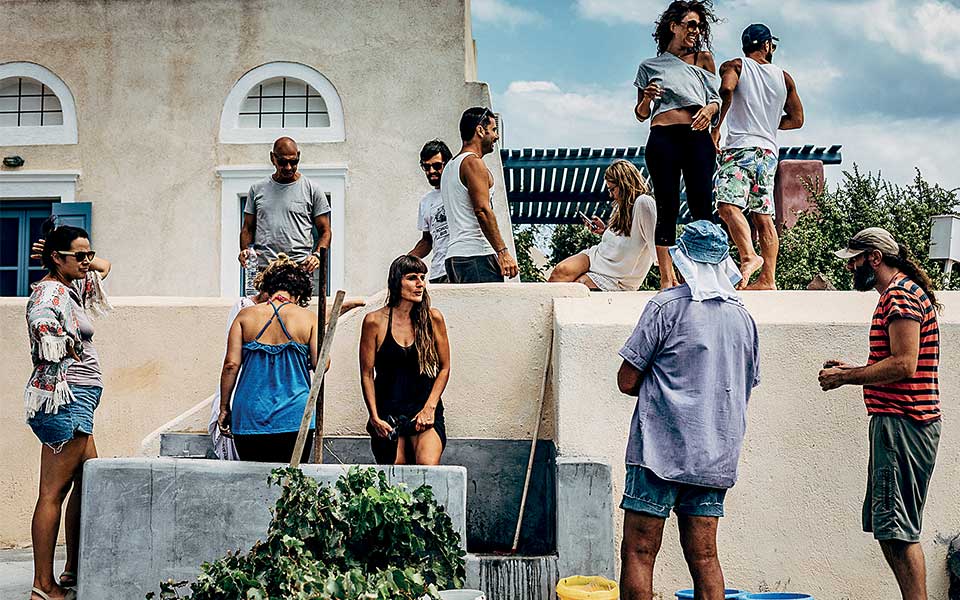
© Vangelis Paravas
The oak factor: Whether oak is needed or not is a point of debate; the best oaked examples, however, display a lovely, creamy, toasty complexity reminiscent of a white Burgundy. Santorini Nychteri used to be made by pressing the grapes the night immediately following the harvest.
Although the name still exists today, Nychteri can now be many things, as regulations simply state that it contain a minimum 13.5% abv and undergo three months’ maturation in oak. Some producers, therefore, try for a more elegant, discreetly oaked style, while others go for a full-bodied, oxidative style with a nutty, honeyed character. Lately, some are also experimenting with vessels such as concrete eggs and clay amphoras for fermentation and maturation, presenting new interpretations of the variety.
Late releases: This new trend on the island sees producers bringing wines with considerable bottle ageing (up to two years) to market. This serves a dual purpose; increasing the perceived value and giving the wine a chance to shine and reveal its true colors and personality.
Vinsanto: “Vin of Santorini” is not to be confused with Vin Santo from Tuscany, which is made from entirely different varieties using other methods. Vinsanto is the island’s sweet wine; it’s produced from sun-dried grapes, mainly Assyrtiko and Aidani (by law, the wine must be made using a minimum of 51% Assyrtiko).
This naturally sweet wine undergoes an oxidative ageing process and matures in old oak for years, or even decades. Vinsantos are lusciously sweet, complex elixirs; they are among the best sweet wines of the world, almost literally immortal, with an ageing potential of centuries.
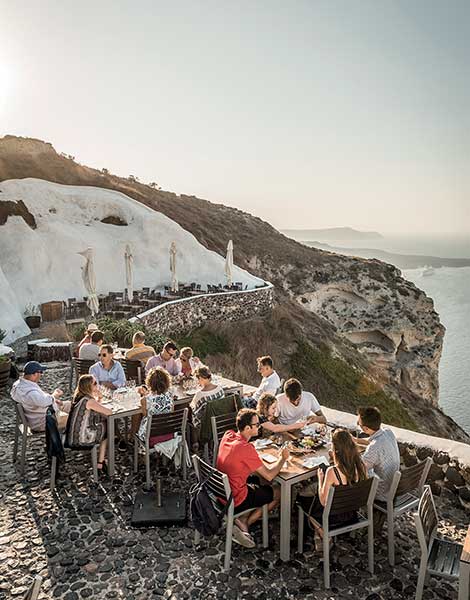
© Malte Jaeger/Laif
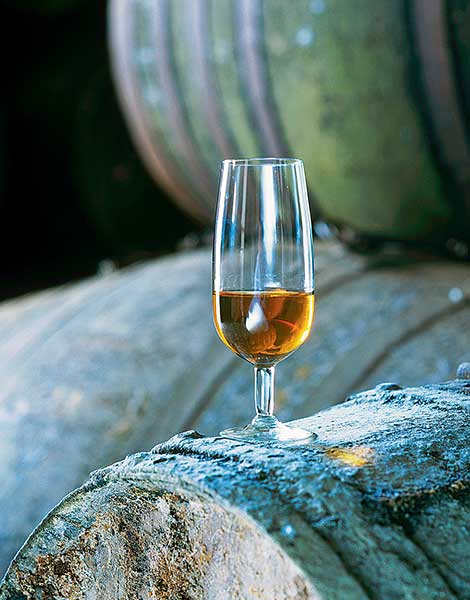
© Visualhellas.gr
THE OTHER VARIETIES
White varieties hold sway in the vineyards of Santorini. Assyrtiko covers approximately 75% of the total 1100 hectares that are planted with grape vines on the island.
The Aidani comes second, and usually plays the role of blending partner for Assyrtiko. There has been, however, lately a trend towards bottling 100% Aidani, as a more aromatic wine alternative. Varietal Aidanis display a lovely floral and herbal complexity, without losing Santorini’s mineral footprint, although the exact wine style varies among producers.
As for the red varieties, Mavrotragano, an indigenous variety of Santorini, is on the rise. In the late ‘90s, producers such as Sigalas and Hatzidakis brought it back from near extinction, and this exotic grape nowadays accounts for about 2% of the Santorini plantings. It’s high tannin load means that this variety needs special care regarding cultivation and vinification. Mavrotragano wines reveal a nose full of black fruits, lavender and herbs, supplemented by firm tannins and a mineral-rich palate.
Other varieties worth mentioning are the red Mandilaria, a capricious variety producing full-throttled tannic wines that demand extended bottle ageing, and what locals call the “Xenoloo” varieties: Gaidouria, Katsano and Voudomato. Most of them find their way in blends, although a few varietals do exist.
HOW SANTORINI AGES
Everyone talks about the stunning personality of the wines of Santorini, with their benchmark saltiness and uncompromising combination of high acidity and alcohol. They also praise the long ageing potential of these wines; however, old vintages are a very rare find, as producers have started holding back vintages recently.
A blind tasting I performed a few months ago for karakasis.mw revealed some interesting finds regarding the ageing potential of the wines. Santorini wine can certainly age, though it can be inconsistent, and bottle variation can be an issue. Screw cap closures seem to be a way forward.
The best examples show no sign of fatigue; they exhibit pale colors and an amazing nutty, toasty character like that of a Hunter Valley Semillon. At present, it seems 5-8 years is a safe drinking window for these wines, but I’m sure that, with the progress already seen on the island, future tastings of old vintages may show even better results.
Vino di Santorini
Vinsanto is the traditional dessert wine of Santorini (Vino di Santorini), produced from sun-dried grapes, the majority of which must be Assyrtiko. It acquires a minimum final alcohol of 9%. The sun-drying process is an ancient, ultra-traditional technique, first reported by Hesiod, which dehydrates the berries while increasing total acidity (high to begin with, thanks to the dominant presence of Assyrtiko) along with the sugars. This means that, while Vinsanto is extremely sweet (residual sugar levels can reach more than 300 g/lt), it’s never cloying, because of that prominent acidity.
The production method is laborious, and yields are so restricted it’s entirely possible that one plant might produce only a single bottle of Vinsanto. The wines develop a complex aromatic flavor profile, with aromas ranging from dried fruits like raisins and figs to roasted nuts, walnuts, chocolate, coffee and caramel.
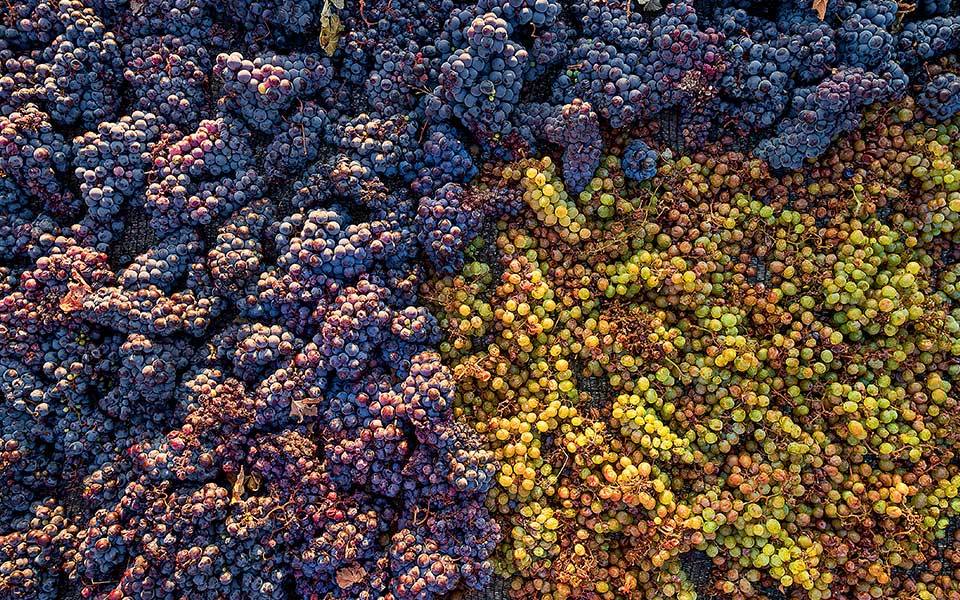
© Vangelis Paravas
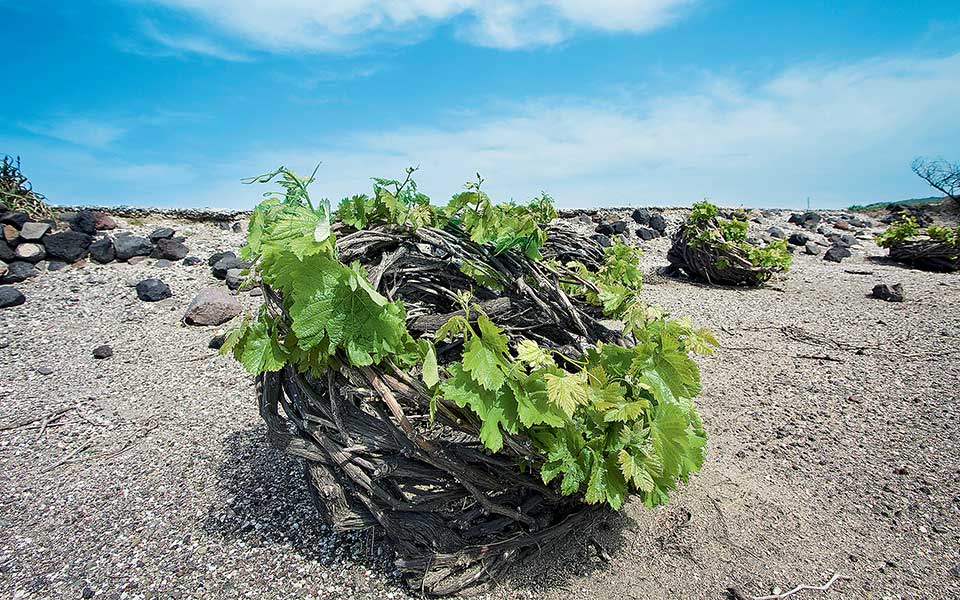
© Shuttestock
IN A GLOBAL CONTEXT
Santorini is the driving force of the Greek wine industry in the demanding export markets. Assyrtiko’s virtues have been lauded by wine professionals around the world, and it’s the first Greek grape variety to be planted in other countries, including Australia, South Africa, Italy and Lebanon, by quality-minded wine producers. From a global perspective, Santorini has really raised the image of Greek wine, gaining respect and acclaim.
An important concern, however, is the price of Santorini’s wines or, more specifically, the rate of price increases for the last few vintages. Santorini prices are now firmly in the fine wine category, comparable to Burgundy whites (entry-level wines are at Bourgogne Blanc prices, and the higher cuvées are matching many Village and 1er Crus), serious German Rieslings and other top whites around the world. Of course, the economic realities of the island mean that wine production was unsustainable at the previously low prices, but the speed of the price rise is something that worries the wine industry.
The best examples of Santorini wines are, without a doubt, premium wines that deserve to be taken seriously on the international stage, but there is a danger that prices are moving faster than the reputation is being built, and that will make it difficult to sell the wines in competitive export markets, if the situation continues. Of course, Santorini always has the advantage of its status as a global tourism destination, but there’s still work to do – both in terms of communicating the message of the island’s unique terroir and in raising the quality of the wines.
INVESTING IN SANTORINI
It’s really exciting to hear the positive buzz being made about the magnificent wines of Santorini. These wines truly deserve their place among the finest white wines in the world.
However, according to respected wine journalist Eric Asimov, “Most people, including many who consider themselves wine lovers, still regard Assyrtiko as something exotic, perhaps even alien.” This statement highlights both the extent to which the variety has been successful, which is remarkable, and the current limitations to that success. Perhaps soon, Santorini‘s best will join those elite wines seen as investment opportunities or collectors’ items. At the moment, they’re still flying under the radar.
Still, prices are rising every year, with increases in domestic market prices of up to 80% over the last five years. This is mainly attributable to the increase in the price of the grapes from €0.85/kg in 2010 to €5/kg in 2018, but it’s also tied to the rise in the number of producers on the island, from 13 in 2010 to more than 20 in 2018.
Bearing this in mind, buying a mixed case or two of Santorini wines for cellaring might end up as a very wise move. It will certainly pay back in terms of enjoyment. Nowadays, more and more producers are releasing special bottlings in such small quantities, they don’t find their way onto many shelves. Stay alert and seek them out!
About the author: Yiannis Karakasis is one of the 355 Masters of Wine in the world. He consults, writes and teaches about wine, and is the founder of the karakasis.mw blog and the author of the ebook “The Vineyards and Wines of Greece 2017.”
FOOD PAIRINGS
With a vast array of styles and varieties available, the wines from Santorini can be seen as perfect partners for a wide variety of dishes.
- Aidani, with its broad aromatic character and balanced freshness, can be a delicious match with seafood, stir-fried vegetables and pasta dishes.
- Assyrtiko, fermented in stainless steel to further accent its mouthwatering minerality, will pair wonderfully with raw shellfish, sea urchins and lemony-sharp fish tartare dishes. You can also opt for fried fish, or any food on which you would squeeze lemon in order to enjoy.
- For an oaky, full-bodied, creamy version of Assyrtiko, look for a prime grilled fish or a white meat dish such as lamb fricassée. Creamy dishes based on other white meat, including chicken or pork, will also work perfectly.
- With its great complexity, weight and density, Nychteri pairs with roasted lamb with yogurt and herbs, or even, in the case of nuttier, more fully developed styles, with a truffle risotto. It also goes with mature yellow cheeses with lots of texture.
- For a red Mavrotragano, stay in classic mode and go for a grilled prime cut or meat casseroles.
- For the ultimate Vinsanto pairing, go beyond chocolate and boost your enjoyment with either a savoury cheese (such as Roquefort) or some prosciutto or pata negra. Don’t forget, however, that it’s always about the moment; the people you are with and the environment you are in will help you get the most out of these excellent pairings.












